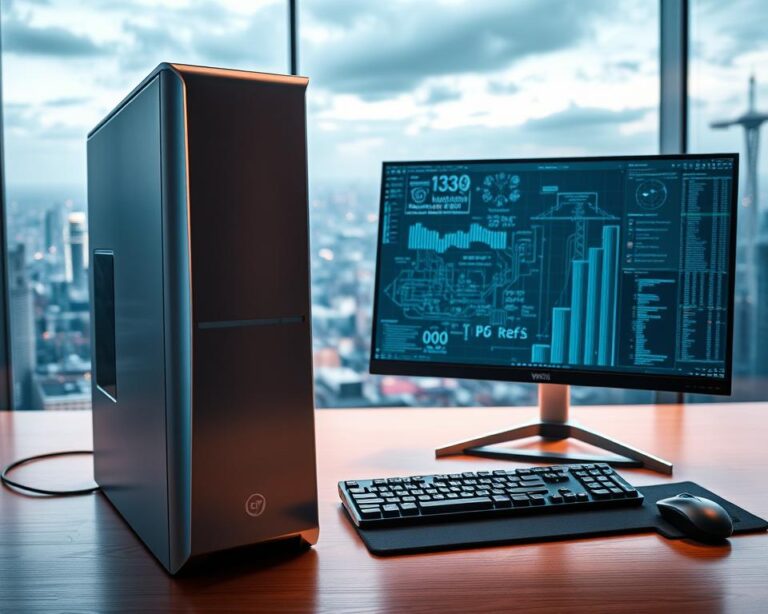
Negative Effects of Technology: An Essay
Did you know that over 70% of Americans feel overwhelmed by the rapid pace of technological change? This statistic underscores the importance of examining the negative effects of technology, as its pervasive influence shapes every aspect of modern life. In this negative effects of technology essay, we will delve into the multi-faceted impacts of technology on our society, particularly focusing on mental health, social dynamics, and behavioral changes.
With the continual rise of digital devices and platforms, it’s vital to understand the societal impact of technology on our daily lives. The objective of this essay is to highlight these pressing issues, facilitating a deeper conversation about how we can address and mitigate the adverse effects of technology in contemporary society.

Key Takeaways
- The rapid pace of technology can overwhelm individuals.
- Understanding the effects of technology is crucial for mental health.
- Technology significantly alters social dynamics.
- Behavioral changes resulting from technology need attention.
- The societal impact of technology is profound and pervasive.
- Addressing negative effects is essential for a balanced lifestyle.
Introduction to Technology and Its Influence on Society
Technology plays a critical role in shaping our daily lives, profoundly altering everything from communication to education. The technology influence is evident in the way information is exchanged, breaking geographical barriers and allowing instant connectivity. As people increasingly rely on digital platforms, the societal changes become more pronounced, with over 90% of adults now utilizing the internet for various activities. This vast online landscape has become essential for learning, social interaction, and accessing news.
One significant aspect of the impact of technology is how it transforms interpersonal relationships. Face-to-face interactions are often replaced by virtual ones, affecting the depth of connections. In educational settings, technology serves as a powerful tool, enabling new learning methodologies. Online courses and resources provide access to a variety of knowledge, catering to diverse learning styles and needs.

Despite its advantages, some societal changes pose challenges. As more individuals become immersed in technology, issues such as digital addiction emerge, potentially damaging mental health and well-being. Balancing the benefits of technology with its drawbacks remains crucial in navigating this modern landscape. Understanding the multifaceted impact of technology is vital for adapting to and addressing the ongoing changes within our society.
Understanding the Negative Effects of Technology Essay
The dual nature of technology presents both advantages and disadvantages, impacting individuals and society at large. While innovative tools enhance communication, productivity, and access to information, they can simultaneously lead to significant drawbacks. Understanding these contrasting aspects is vital in navigating our modern world.
The Dual Nature of Technology
Technology serves as a double-edged sword, providing remarkable benefits alongside alarming threats. The dual nature of technology includes conveniences like instant access to knowledge and improved connectivity. Many individuals enjoy rapid online services, social media interactions, and efficiency in daily tasks, leading to an undeniable enhancement in quality of life.
Yet, the negative technology impact manifests through issues such as increased screen time, digital addiction, and privacy concerns. Recognizing this balance is essential for users who seek to harness technology’s benefits while mitigating its risks.
Importance of Addressing Negative Effects
Addressing technology effects requires proactive measures to counterbalance the adverse consequences. Individuals, educators, and policymakers must work collaboratively to promote digital literacy and responsible usage. Encouraging healthy technology habits can empower users to navigate the digital landscape thoughtfully. Without meaningful action, the potential of positive outcomes may be overshadowed by the pitfalls that arise from unchecked technology reliance.

Technology Impact on Society
The societal impact of technology reveals profound transformations within social dynamics, reshaping relationships and interactions. Families experience shifts in structure and communication, influenced heavily by digital platforms. Recognition of these changes provides insight into how technology alters the fabric of our lives.
Changing Social Dynamics
Many experts note that family dynamics evolve in the digital age. The societal impact of technology includes an increasing reliance on electronic communication, which can lead to reduced quality in interpersonal relationships. Families may find themselves seated together but engaged in separate digital interactions, rather than enjoying meaningful conversations. This phenomenon raises concerns, as technology creates a balance between connectivity and emotional distance.
Altered Communication Patterns
Communication changes significantly within society due to technology. Texting and social media often replace traditional dialogue, affecting how individuals relate and connect. While these platforms facilitate instant communication, the lack of face-to-face interaction can diminish the authenticity of relationships. Individuals may feel isolated despite being constantly “plugged in.” Understanding these shifts in communication is crucial for navigating the evolving landscape of social dynamics in both personal and community contexts.

Digital Addiction Consequences
Digital addiction has become a prevalent issue in today’s society, impacting various facets of life. Individuals often find themselves drawn to their screens, experiencing the pull of social media, streaming platforms, and online gaming. As these activities offer instant gratification, they contribute to a cycle of excessive screen time that can be hard to break.
The technology addiction consequences extend beyond mere distraction. Research indicates that prolonged exposure to screens can lead to a range of health-related issues. For instance, studies suggest that excessive screen time may result in sleep disturbances, headaches, and vision problems. As people struggle to find a healthy balance, the effects can ripple through both physical and mental well-being.
Furthermore, the impact of digital addiction often manifests in daily life, affecting relationships and productivity. When screen time overshadows face-to-face interactions and essential responsibilities, individuals may feel isolated and unfulfilled. Recognizing the signs of digital addiction is crucial in addressing this growing concern and fostering healthier habits.

Harmful Effects of Screen Time
The increasing prevalence of screens in daily life has raised concerns about their impact on both physical and mental health. The harmful effects of screen time extend beyond just the interaction with gadgets, delving into significant physical health issues and the pervasive mental fatigue that often accompanies excessive screen use.
Physical Health Concerns
Prolonged screen exposure can lead to various physical health issues, affecting individuals of all ages. Common problems include:
- Eye strain: Staring at screens for extended periods may cause discomfort, dryness, and blurred vision.
- Sleep disturbances: The blue light emitted from screens can disrupt circadian rhythms, leading to difficulties in sleeping.
- Obesity: Sedentary behavior associated with screen time can contribute to weight gain and related health complications.
Mental Fatigue and Burnout
Along with physical repercussions, many experience mental fatigue and burnout due to excessive screen interaction. Studies suggest that constant engagement with digital devices can lead to:
- Decreased concentration: Continuous notifications and distractions from screens can impair focus and productivity.
- Higher stress levels: The pressure to remain connected can lead to anxiety and feelings of being overwhelmed.
- Declines in mental well-being: Extended screen time often correlates with increased feelings of frustration and mental exhaustion.
Technology and Mental Health
As technology continues to permeate our daily lives, its effects on mental health become increasingly evident. Research suggests that the relationship between technology and mental health introduces complexities in human emotions, particularly in mental well-being. Anxiety levels have surged among individuals immersed in the digital landscape, leading to concerns over our mental resilience.
Increased Anxiety Levels
Excessive engagement with technology often elevates anxiety levels. Many individuals find themselves caught in cycles of constant notifications and social media updates, which can provoke stress and unease. The pressure to respond promptly or maintain a flawless online persona creates an environment ripe for anxiety. Studies indicate that frequent use of social networks correlates with heightened feelings of anxiety, transforming how we perceive real-time social interaction.
Depression Linked to Technology Use
Depression from technology usage stands as another significant concern. Many users experience feelings of inadequacy when comparing themselves to curated lives presented on social media. This cycle of negative self-comparison can lead to feelings of isolation and sadness. The detrimental effects of screen time often overshadow genuine connections, resulting in a decline in overall mental health. Addressing the implications of technology on mental well-being is crucial to fostering a healthier relationship with our digital devices.
Social Media Influence on Behavior
The social media impact on behavior is profound, particularly concerning how it affects self-esteem. Many users, especially young individuals, often compare themselves to the curated lives presented on platforms like Instagram and Facebook. This phenomenon can lead to significant self-esteem issues as they measure their worth against unrealistic standards showcased online.
Impact on Self-Esteem
Studies indicate that exposure to idealized images can result in feelings of inadequacy among users. The constant barrage of perfect photos often triggers self-doubt and dissatisfaction with one’s appearance or achievements. As a result, many individuals may experience diminished self-worth, leading to anxiety and depression.
Normalization of Cyberbullying
Alongside self-esteem challenges, the normalization of cyberbullying has become a significant concern in the digital age. Statistics reveal alarmingly high rates of online harassment, particularly among teenagers. Programs implemented by various social media companies are not always enough to combat this issue effectively. Victims of cyberbullying frequently endure long-lasting psychological effects, often leading to serious mental health repercussions.
Ethical Concerns with Tech Advancement
As technology rapidly evolves, the ethical concerns in technology become more pronounced. Issues surrounding data privacy and security dominate discussions among consumers and experts alike. With every innovative solution comes the responsibility to safeguard personal information. Companies must prioritize transparency to build trust with their users.
AI developments raise significant tech advancement issues, revealing the potential for bias in algorithms and automation decisions. Ethical guidelines must be established to mitigate adverse impacts of technology on individuals and communities. With society increasingly relying on these systems, the implications of technology ethics should be a primary consideration in tech design and deployment.
Practitioners in the tech industry face the challenge of balancing innovation with ethical responsibility. In this digital age, it’s essential for stakeholders to engage in ongoing dialogues about ethical dilemmas, ensuring that advancements lead to positive societal change rather than unintended harm.
Tech Dependence and Anxiety
As technology becomes integrated into daily life, understanding tech dependence symptoms has gained importance. Many individuals experience compulsive checking of devices, which can heighten levels of anxiety from technology. Withdrawal symptoms may arise when devices are out of reach, further complicating the relationship with technology. Recognizing these signs is the first step towards addressing this growing concern.
Symptomatology of Tech Dependence
Common tech dependence symptoms manifest in various ways. Users may notice that they spend excessive time on their devices, leading to neglect of offline activities. Signs include:
- Frequent feelings of restlessness when not using technology
- Difficulty focusing on tasks without interruptions from devices
- Social isolation as online interactions replace face-to-face communication
Identifying these symptoms can facilitate conversations about overcoming technology anxiety and finding balance in digital interactions.
Strategies for Overcoming Dependence
Overcoming technology anxiety requires intentional strategies that foster healthier habits. Consider implementing the following methods:
- Digital Detox: Designate specific times each day or week to unplug completely from devices.
- Mindfulness Practices: Engage in mindfulness exercises, such as meditation or breathing techniques, to reduce anxiety from technology.
- Limit Notifications: Adjust settings to minimize distractions and promote focused work sessions.
These approaches not only help mitigate tech dependence symptoms but also support overall well-being, encouraging a more balanced lifestyle.
Cyberbullying Effects
Cyberbullying has become a pervasive issue among adolescents, impacting their social interactions and mental well-being. The adolescent bullying prevalence in online environments is alarming, with a significant percentage of teens encountering this disturbing behavior. Understanding the implications of such experiences is vital for fostering a safer digital landscape.
Prevalence Among Adolescents
Statistics indicate that a substantial number of adolescents have experienced some form of cyberbullying. Surveys reveal that approximately 34% of students have been victims of online harassment. This phenomenon often manifests through social media platforms, gaming sites, and messaging services. The anonymity provided by technology can exacerbate the likelihood of such interactions, making it crucial to address the issues surrounding cyberbullying.
Long-Term Psychological Impact
The psychological impact of cyberbullying can extend well beyond the initial experience. Victims often exhibit low self-esteem, leading to feelings of worthlessness and depression. Research has consistently shown that the long-term effects can include anxiety and social withdrawal. Many individuals struggle to rebuild their confidence and reconnect socially after enduring such trauma. To mitigate these cyberbullying effects, raising awareness and implementing preventive measures in schools and communities is essential.
Technology Addiction Implications
Technology addiction implications extend beyond individual experiences, affecting various societal components. The addiction effects can lead to decreased productivity in workplaces and educational settings. For students, excessive screen time can disrupt study routines, impacting their overall academic performance.
In personal lives, the behavioral consequences of technology addiction manifest in strained relationships. Individuals may prioritize device interaction over face-to-face communication, reducing meaningful connections with family and friends. As a result, feelings of isolation and loneliness may increase, further deepening the addiction effects.
Understanding these implications aids in recognizing the importance of managing technology use. By promoting healthier habits, society can mitigate the adverse effects of technology addiction, thus enhancing both personal well-being and community dynamics.
| Area Affected | Negative Impacts |
|---|---|
| Work Productivity | Lowered efficiency and missed deadlines |
| Academic Performance | Disruption of study habits leading to declining grades |
| Relationships | Increased isolation due to lack of personal interaction |
Impact of Technology on Interpersonal Relationships
Technology plays a pivotal role in shaping our social interactions. While it offers convenience, an alarming trend has emerged regarding the impact of technology on relationships. The shift toward digital communication has resulted in significant decreases in face-to-face interactions, which are vital for nurturing genuine connections. As technology continues to evolve, understanding its effect on personal relationships becomes increasingly important.
Decrease in Face-to-Face Interactions
In recent years, many individuals have turned to messaging apps and social media platforms as their primary means of communication. This change has led to a noticeable decline in face-to-face interactions. While technology and relationships can coexist, over-reliance on screens has diminished the quality of connections that come from physical presence. Many experience this disconnect, even when surrounded by others.
Fostering Isolation and Loneliness
Loneliness fostered by technology is becoming increasingly prevalent, especially among younger generations. Social media may create the illusion of connectedness, yet it often reinforces feelings of isolation. Many individuals report feeling lonely despite having numerous online friends. The emotional depth that can only be achieved through direct human interactions is lost in the digital space. Addressing these feelings requires a conscious effort to reconnect with others in more meaningful ways.
Educational Challenges Posed by Technology
The rise of technology in educational settings often introduces various challenges that can hinder student learning and academic success. While technology can enhance learning experiences, it frequently brings about distractions in learning environments. These distractions significantly impact student focus and engagement, raising academic concerns that deserve attention.
Distraction in Learning Environments
Students today face numerous distractions stemming from technology. Devices such as smartphones, tablets, and laptops, while invaluable tools for research and collaboration, can lead to frequent diversions. Notifications from social media and apps often interrupt the learning process. Research shows that these distractions in learning negatively correlate with student concentration, resulting in diminished retention of information.
Academic Performance Concerns
As technology becomes increasingly prevalent in classrooms, academic performance concerns surface. Studies link excessive technology use with declines in grades and overall academic achievement. Many students may prioritize entertainment over education, leading to incomplete assignments and inadequate study habits. Addressing these educational challenges technology presents is crucial for fostering a productive learning environment.
Work-Life Balance and Technology
The advent of work-life balance technology has transformed how individuals manage their professional and personal lives. With the rise of technology in the workplace, the boundary between work hours and home life grows increasingly blurred. This constant connectivity can lead to heightened professional stress, as employees feel pressured to respond to emails or messages outside of traditional office hours.
Many people struggle to disconnect from work tasks due to the ever-present devices at their fingertips. Smart technology and communication tools promote convenience, yet they also create an expectation of immediate availability. This phenomenon can deeply impact mental well-being, as constant engagement often leads to feelings of exhaustion and burnout.
Effective work-life balance requires establishing boundaries that separate personal time from work obligations. Employees may benefit from setting specific hours for work communication and cultivating habits that minimize distractions during non-work hours. By implementing intentional practices, individuals can reclaim time for relaxation and personal interests, ultimately reducing professional stress.
Government Regulation and Technology
As technology continues to evolve at a rapid pace, the need for effective government regulation technology becomes increasingly apparent. Policymakers face the challenge of protecting public interests while fostering innovation. This section examines the role of policy management and the impact of public awareness initiatives aimed at mitigating negative effects associated with technology use.
Role of Policy in Managing Tech Use
Governments across various nations are implementing regulations that focus on responsible technology usage. Examples include laws addressing data privacy and cybersecurity. Such policies aim to create a safer digital environment for all users. Regulation also plays a pivotal role in ensuring that technology companies uphold ethical standards, helping to prevent abuses of power and misinformation.
Public Awareness Initiatives
Raising public awareness about the implications of technology use is essential. Initiatives aimed at educating consumers and businesses serve to highlight the potential risks of technology addiction, online harassment, and privacy violations. Campaigns that promote healthy tech habits contribute to a more informed public that can make better decisions regarding their digital interactions.
| Country | Policy Focus | Public Awareness Campaigns |
|---|---|---|
| United States | Data Privacy | Digital Literacy Initiatives |
| Germany | Cybersecurity | Online Safety Programs |
| United Kingdom | Content Regulation | Social Media Awareness |
The synergy between government regulation technology and proactive public awareness campaigns is crucial. By ensuring that policies address emerging issues, authorities can create a more secure technological landscape for society as a whole.
The Future of Technology: A Critical Perspective
As society strides into an era defined by rapid technology evolution, a profound critical analysis of technology becomes essential. The landscape of innovation is constantly shifting, presenting both opportunities and challenges. Envisioning a future technology perspective requires an understanding of potential advancements, including artificial intelligence, quantum computing, and biotechnology.
Technological progress often introduces unforeseen consequences. As technology continues to evolve, assessing its implications on privacy, ethics, and social behavior warrants attention. The importance of formulating proactive measures to mitigate negative effects cannot be understated. Education, regulation, and awareness initiatives play pivotal roles in guiding society toward a balanced integration of emerging technologies.
With the advent of smart devices and interconnected systems, a critical approach will help navigate issues such as data security and misinformation. An ongoing dialogue about the ethical use of technology serves as a foundation for a future where innovation aligns with societal well-being. Embracing this perspective allows stakeholders to envision a technology landscape that prioritizes human values while fostering progress.
Conclusion
As we emerge from our exploration of the negative effects of technology, it is crucial to take a moment for technology reflection. Throughout the discussions, we have seen various angles, from digital addiction and social media influence to educational challenges and their implications on mental health. Summarizing technology effects reveals a landscape that, while filled with innovation, is equally riddled with concerns that cannot be ignored.
The conclusion on technology impact is not merely about positing these challenges, but rather it prompts each of us to consider our individual relationship with technology. How often do we disconnect from the digital world to engage meaningfully with those around us? As our society becomes increasingly intertwined with technological advancements, we must advocate for a balanced approach that prioritizes mental and social well-being.
In closing, understanding and addressing the adverse consequences of technology is imperative for forging a healthier relationship with our devices and platforms. The journey toward a more mindful usage of technology begins with awareness, leading to actionable steps that safeguard both personal well-being and community connection.



